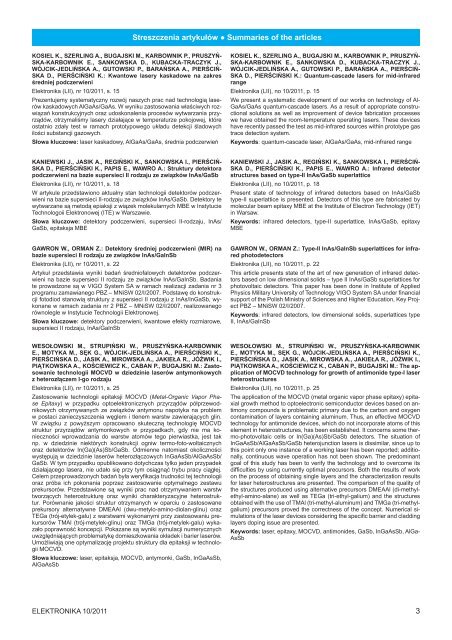Elektronika 2011-10 I.pdf - Instytut Systemów Elektronicznych ...
Elektronika 2011-10 I.pdf - Instytut Systemów Elektronicznych ...
Elektronika 2011-10 I.pdf - Instytut Systemów Elektronicznych ...
- No tags were found...
You also want an ePaper? Increase the reach of your titles
YUMPU automatically turns print PDFs into web optimized ePapers that Google loves.
Streszczenia artykułów ● Summaries of the articlesKOSIEL K., SZERLING A., BUGAJSKI M., KARBOWNIK P., PRUSZYŃ-SKA-KARBOWNIK E., SANKOWSKA D., KUBACKA-TRACZYK J.,WÓJCIK-JEDLIŃSKA A., GUTOWSKI P., BARAŃSKA A., PIERŚCIŃ-SKA D., PIERŚCIŃSKI K.: Kwantowe lasery kaskadowe na zakresśredniej podczerwieni<strong>Elektronika</strong> (LII), nr <strong>10</strong>/<strong>2011</strong>, s. 15Prezentujemy systematyczny rozwój naszych prac nad technologią laserówkaskadowych AlGaAs/GaAs. W wyniku zastosowania właściwych rozwiązańkonstrukcyjnych oraz udoskonalenia procesów wytwarzania przyrządów,otrzymaliśmy lasery działające w temperaturze pokojowej, któreostatnio zdały test w ramach prototypowego układu detekcji śladowychilości substancji gazowych.Słowa kluczowe: laser kaskadowy, AlGaAs/GaAs, średnia podczerwieńKOSIEL K., SZERLING A., BUGAJSKI M., KARBOWNIK P., PRUSZYŃ-SKA-KARBOWNIK E., SANKOWSKA D., KUBACKA-TRACZYK J.,WÓJCIK-JEDLIŃSKA A., GUTOWSKI P., BARAŃSKA A., PIERŚCIŃ-SKA D., PIERŚCIŃSKI K.: Quantum-cascade lasers for mid-infraredrange<strong>Elektronika</strong> (LII), no <strong>10</strong>/<strong>2011</strong>, p. 15We present a systematic development of our works on technology of Al-GaAs/GaAs quantum-cascade lasers. As a result of appropriate constructionalsolutions as well as improvement of device fabrication processeswe have obtained the room-temperature operating lasers. These deviceshave recently passed the test as mid-infrared sources within prototype gastrace detection system.Keywords: quantum-cascade laser, AlGaAs/GaAs, mid-infrared rangeKANIEWSKI J., JASIK A., REGIŃSKI K., SANKOWSKA I., PIERŚCIŃ-SKA D., PIERŚCIŃSKI K., PAPIS E., WAWRO A.: Struktury detektorapodczerwieni na bazie supersieci II rodzaju ze związków InAs/GaSb<strong>Elektronika</strong> (LII), nr <strong>10</strong>/<strong>2011</strong>, s. 18W artykule przedstawiono aktualny stan technologii detektorów podczerwienina bazie supersieci II-rodzaju ze związków InAs/GaSb. Detektory tewytwarzane są metodą epiaksji z wiązek molekularnych MBE w InstytucieTechnologoii Elektronowej (ITE) w Warszawie.Słowa kluczowe: detektory podczerwieni, supersieci II-rodzaju, InAs/GaSb, epitaksja MBEKANIEWSKI J., JASIK A., REGIŃSKI K., SANKOWSKA I., PIERŚCIŃ-SKA D., PIERŚCIŃSKI K., PAPIS E., WAWRO A.: Infrared detectorstructures based on type-II InAs/GaSb superlattice<strong>Elektronika</strong> (LII), no <strong>10</strong>/<strong>2011</strong>, p. 18Present state of technology of infrared detectors based on InAs/GaSbtype-II superlattice is presented. Detectors of this type are fabricated bymolecular beam epitaxy MBE at the Institute of Electron Technology (IET)in Warsaw.Keywords: infrared detectors, type-II superlattice, InAs/GaSb, epitaxyMBEGAWRON W., ORMAN Z.: Detektory średniej podczerwieni (MIR) nabazie supersieci II rodzaju ze związków InAs/GaInSb<strong>Elektronika</strong> (LII), nr <strong>10</strong>/<strong>2011</strong>, s. 22Artykuł przedstawia wyniki badań średniofalowych detektorów podczerwienina bazie supersieci II rodzaju ze związków InAs/GaInSb. Badaniate prowadzone są w VIGO System SA w ramach realizacji zadania nr 3programu zamawianego PBZ – MNiSW 02/I/2007. Podstawę do konstrukcjifotodiod stanowią struktury z supersieci II rodzaju z InAs/InGaSb, wykonanew ramach zadania nr 2 PBZ – MNiSW 02/I/2007, realizowanegorównolegle w Instytucie Technologii Elektronowej.Słowa kluczowe: detektory podczerwieni, kwantowe efekty rozmiarowe,supersieci II rodzaju, InAs/GaInSbGAWRON W., ORMAN Z.: Type-II InAs/GaInSb superlattices for infraredphotodetectors<strong>Elektronika</strong> (LII), no <strong>10</strong>/<strong>2011</strong>, p. 22This article presents state of the art of new generation of infrared detectorsbased on low dimensional solids – type II InAs/GaSb superlattices forphotovoltaic detectors. This paper has been done in Institute of AppliedPhysics Military University of Technology VIGO System SA under financialsupport of the Polish Ministry of Sciences and Higher Education, Key ProjectPBZ – MNiSW 02/I/2007.Keywords: infrared detectors, low dimensional solids, superlattices typeII, InAs/GaInSbWESOŁOWSKI M., STRUPIŃSKI W., PRUSZYŃSKA-KARBOWNIKE., MOTYKA M., SĘK G., WÓJCIK-JEDLIŃSKA A., PIERŚCIŃSKI K.,PIERŚCIŃSKA D., JASIK A., MIROWSKA A., JAKIEŁA R., JÓŹWIK I.,PIĄTKOWSKA A., KOŚCIEWICZ K., CABAN P., BUGAJSKI M.: Zastosowanietechnologii MOCVD w dziedzinie laserów antymonkowychz heterozłączem I-go rodzaju<strong>Elektronika</strong> (LII), nr <strong>10</strong>/<strong>2011</strong>, s. 25Zastosowanie technologii epitaksji MOCVD (Metal-Organic Vapor PhaseEpitaxy) w przypadku optoelektronicznych przyrządów półprzewodnikowychotrzymywanych ze związków antymonu napotyka na problemw postaci zanieczyszczenia węglem i tlenem warstw zawierających glin.W związku z powyższym opracowano skuteczną technologię MOCVDstruktur przyrządów antymonkowych w przypadkach, gdy nie ma koniecznościwprowadzania do warstw atomów tego pierwiastka, jest taknp. w dziedzinie niektórych konstrukcji ogniw termo-foto-woltaicznychoraz detektorów In(Ga)(As)Sb/GaSb. Odmienne natomiast okolicznościwystępują w dziedzinie laserów heterozłączowych InGaAsSb/AlGaAsSb/GaSb. W tym przypadku opublikowano dotychczas tylko jeden przypadekdziałającego lasera, nie udało się przy tym osiągnąć trybu pracy ciągłej.Celem przeprowadzonych badań była weryfikacja trudności tej technologiioraz próba ich pokonania poprzez zastosowanie optymalnego zestawuprekursorów. Przedstawione są wyniki prac nad otrzymywaniem warstwtworzących heterostrukturę oraz wyniki charakteryzacyjne heterostruktur.Porównanie jakości struktur otrzymanych w oparciu o zastosowaneprekursory alternatywne DMEAAl (dwu-metylo-amino-diolan-glinu) orazTEGa (trój-etylek-galu) z warstwami wykonanymi przy zastosowaniu prekursorówTMAl (trój-metylek-glinu) oraz TMGa (trój-metylek-galu) wykazałopoprawność koncepcji. Pokazane są wyniki symulacji numerycznychuwzględniających problematykę domieszkowania okładek i barier laserów.Umożliwiają one optymalizację projektu struktury dla epitaksji w technologiiMOCVD.Słowa kluczowe: laser, epitaksja, MOCVD, antymonki, GaSb, InGaAsSb,AlGaAsSbWESOŁOWSKI M., STRUPIŃSKI W., PRUSZYŃSKA-KARBOWNIKE., MOTYKA M., SĘK G., WÓJCIK-JEDLIŃSKA A., PIERŚCIŃSKI K.,PIERŚCIŃSKA D., JASIK A., MIROWSKA A., JAKIEŁA R., JÓŹWIK I.,PIĄTKOWSKA A., KOŚCIEWICZ K., CABAN P., BUGAJSKI M.: The applicationof MOCVD technology for growth of antimonide type-I laserheterostructures<strong>Elektronika</strong> (LII), no <strong>10</strong>/<strong>2011</strong>, p. 25The application of the MOCVD (metal organic vapor phase epitaxy) epitaxialgrowth method to optoelectronic semiconductor devices based on antimonycompounds is problematic primary due to the carbon and oxygencontamination of layers containing aluminum. Thus, an effective MOCVDtechnology for antimonide devices, which do not incorporate atoms of thiselement in heterostructures, has been established. It concerns some thermo-photovoltaiccells or In(Ga)(As)Sb/GaSb detectors. The situation ofInGaAsSb/AlGaAsSb/GaSb heterojunction lasers is dissimilar, since up tothis point only one instance of a working laser has been reported; additionally,continuous wave operation has not been shown. The predominantgoal of this study has been to verify the technology and to overcome itsdifficulties by using currently optimal precursors. Both the results of workon the process of obtaining single layers and the characterization resultsfor laser heterostructures are presented. The comparison of the quality ofthe structures produced using alternative precursors DMEAAl (di-methylethyl-amino-alane)as well as TEGa (tri-ethyl-galium) and the structuresobtained with the use of TMAl (tri-methyl-aluminum) and TMGa (tri-methylgalium)precursors proved the correctness of the concept. Numerical simulationsof the laser devices considering the specific barrier and claddinglayers doping issue are presented.Keywords: laser, epitaxy, MOCVD, antimonides, GaSb, InGaAsSb, AlGa-AsSb<strong>Elektronika</strong> <strong>10</strong>/<strong>2011</strong>
















